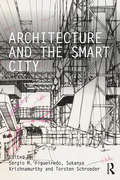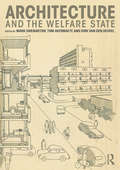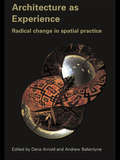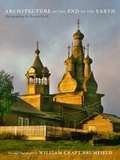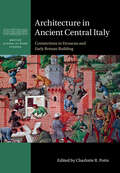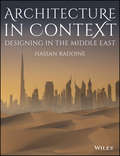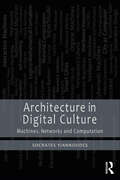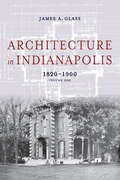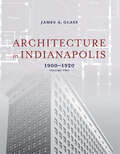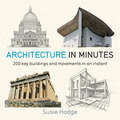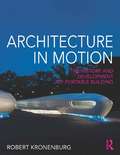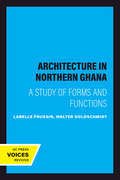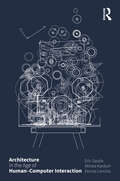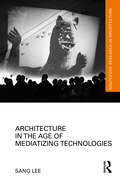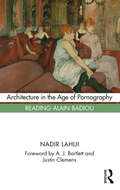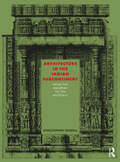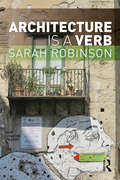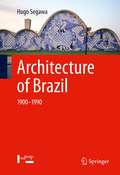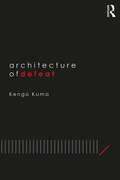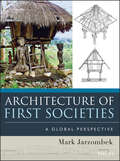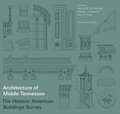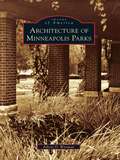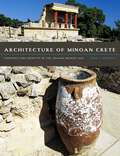- Table View
- List View
Architecture and the Smart City
by Sergio M. Figueiredo Sukanya Krishnamurthy Torsten SchroederIncreasingly the world around us is becoming ‘smart.’ From smart meters to smart production, from smart surfaces to smart grids, from smart phones to smart citizens. ‘Smart’ has become the catch-all term to indicate the advent of a charged technological shift that has been propelled by the promise of safer, more convenient and more efficient forms of living. Most architects, designers, planners and politicians seem to agree that the smart transition of cities and buildings is in full swing and inevitable. However, beyond comfort, safety and efficiency, how can ‘smart design and technologies’ assist to address current and future challenges of architecture and urbanism? Architecture and the Smart City provides an architectural perspective on the emergence of the smart city and offers a wide collection of resources for developing a better understanding of how smart architecture, smart cities and smart systems in the built environment are discussed, designed and materialized. It brings together a range of international thinkers and practitioners to discuss smart systems through four thematic sections: ‘Histories and Futures’, ‘Agency and Control’, ‘Materialities and Spaces’ and ‘Networks and Nodes’. Combined, these four thematic sections provide different perspectives into some of the most pressing issues with smart systems in the built environment. The book tackles questions related to the future of architecture and urbanism, lessons learned from global case studies and challenges related to interdisciplinary research, and critically examines what the future of buildings and cities will look like.
Architecture and the Welfare State
by Tom Avermaete Mark Swenarton Dirk van den HeuvelIn the decades following World War Two, and in part in response to the Cold War, governments across Western Europe set out ambitious programmes for social welfare and the redistribution of wealth that aimed to improve the everyday lives of their citizens. Many of these welfare state programmes - housing, schools, new towns, cultural and leisure centres – involved not just construction but a new approach to architectural design, in which the welfare objectives of these state-funded programmes were delineated and debated. The impact on architects and architectural design was profound and far-reaching, with welfare state projects moving centre-stage in architectural discourse not just in Europe but worldwide. This is the first book to explore the architecture of the welfare state in Western Europe from an international perspective. With chapters covering Austria, Belgium, France, Germany, Italy, The Netherlands, Sweden and the UK, the book explores the complex role played by architecture in the formation and development of the welfare state in both theory and practice. Themes include: the role of the built environment in the welfare state as a political project the colonial dimension of European welfare state architecture and its ‘export’ to Africa and Asia the role of welfare state projects in promoting consumer culture and economic growth the picture of the collective produced by welfare state architecture the role of architectural innovation in the welfare state the role of the architect, as opposed to construction companies and others, in determining what was built the relationship between architectural and social theory the role of internal institutional critique and the counterculture. Contributors include: Tom Avermaete, Eve Blau, Nicholas Bullock, Miles Glendinning, Janina Gosseye, Hilde Heynen, Caroline Maniaque-Benton, Helena Mattsson, Luca Molinari, Simon Pepper, Michelle Provoost, Lukasz Stanek, Mark Swenarton, Florian Urban and Dirk van den Heuvel.
Architecture as Experience: Radical Change in Spatial Practice
by Dana Arnold Andrew BallantyneArchitecture as Experience investigates the perception and appropriation of places across intervals of time and culture. The particular concern of the volume is to bring together fresh empirical research and animate it through contact with theoretical sophistication, without overwhelming the material. The chapters establish the continuity of a particular physical object and show it in at least two alternative historical perspectives, in which recognisable features are shown in different lights. The results are often surprising, inverting the common idea of a historic place as having an enduring meaning. This book shows the insight that can be gained from learning about earlier constructions of meaning which have been derived from the same buildings that stand before us today.
Architecture at the End of the Earth: Photographing the Russian North
by William Craft BrumfieldCarpeted in boreal forests, dotted with lakes, cut by rivers, and straddling the Arctic Circle, the region surrounding the White Sea, which is known as the Russian North, is sparsely populated and immensely isolated. It is also the home to architectural marvels, as many of the original wooden and brick churches and homes in the region's ancient villages and towns still stand. Featuring nearly two hundred full color photographs of these beautiful centuries-old structures, Architecture at the End of the Earth is the most recent addition to William Craft Brumfield's ongoing project to photographically document all aspects of Russian architecture.The architectural masterpieces Brumfield photographed are diverse: they range from humble chapels to grand cathedrals, buildings that are either dilapidated or well cared for, and structures repurposed during the Soviet era. Included are onion-domed wooden churches such as the Church of the Dormition, built in 1674 in Varzuga; the massive walled Transfiguration Monastery on Great Solovetsky Island, which dates to the mid-1550s; the Ferapontov-Nativity Monastery's frescoes, painted in 1502 by Dionisy, one of Russia's greatest medieval painters; nineteenth-century log houses, both rustic and ornate; and the Cathedral of St. Sophia in Vologda, which was commissioned by Ivan the Terrible in the 1560s. The text that introduces the photographs outlines the region's significance to Russian history and culture.Brumfield is challenged by the immense difficulty of accessing the Russian North, and recounts traversing sketchy roads, crossing silt-clogged rivers on barges and ferries, improvising travel arrangements, being delayed by severe snowstorms, and seeing the region from the air aboard the small planes he needs to reach remote areas.The buildings Brumfield photographed, some of which lie in near ruin, are at constant risk due to local indifference and vandalism, a lack of maintenance funds, clumsy restorations, or changes in local and national priorities. Brumfield is concerned with their futures and hopes that the region's beautiful and vulnerable achievements of master Russian carpenters will be preserved. Architecture at the End of the Earth is at once an art book, a travel guide, and a personal document about the discovery of this bleak but beautiful region of Russia that most readers will see here for the first time.
Architecture in Ancient Central Italy: Connections in Etruscan and Early Roman Building (British School at Rome Studies)
by Charlotte R. PottsArchitecture in Ancient Central Italy takes studies of individual elements and sites as a starting point to reconstruct a much larger picture of architecture in western central Italy as an industry, and to position the result in space (in the Mediterranean world and beyond) and time (from the second millennium BC to Late Antiquity). This volume demonstrates that buildings in pre-Roman Italy have close connections with Bronze Age and Roman architecture, with practices in local and distant societies, and with the natural world and the cosmos. It also argues that buildings serve as windows into the minds and lives of those who made and used them, revealing the concerns and character of communities in early Etruria, Rome, and Latium. Architecture consequently emerges as a valuable historical source, and moreover a part of life that shaped society as much as reflected it.
Architecture in Context: Designing in the Middle East
by Hassan RadoineArchitecture in Context: Designing in the Middle East provides a foundation for understanding the critical context of architecture and design in this region. It does this by: presenting a practical overview of architectural know-how in the Middle East, and its potential for cultivating a sense of place introducing local architectural vocabularies and styles, and how they can still be reactivated in contemporary design exploring the cultural and contextual meaning of forms as references that may influence contemporary architecture discussing important discourses and trends in architecture that allow a rethinking of the current global/local dichotomy. Highly illustrated, the book covers architecture and design in North Africa, the Levant, the Gulf, and Turkey, Iran and Iraq.
Architecture in Digital Culture: Machines, Networks and Computation
by Socrates YiannoudesThis book examines the manifestations of architecture, cities, and design processes within digital culture. Adopting a comparative and critical method, the author looks at past and present encounters of the digital with architectural discourse and practice. Along three central themes – machines, networks, and computation – the book begins by discussing transformations of the analogy between architecture and the machine since the early twentieth century, foregrounding questions about the relations between architecture, humans, machines, and the environment. It moves on to the city, to observe how big data and smart city sustainable management systems have transformed historical visions of global networked cities. Lastly, it explores computational design thinking historically and in the context of complex systems, as well as the latest technical, social, and economic developments. Exposing possible drawbacks while still focusing on what is radically innovative, this book proposes a way toward more liberating, digital, and sustainable futures for architecture. An important read for architecture students, academics, and professionals, this book connects instances of digital architecture practice and discourse throughout the history of the digital culture paradigm and their ties with sociopolitical developments. It shares the possibility that these connecting lines may be the canvas for a novel architectural history of the recent past.
Architecture in Indianapolis: 1820–1900
by James A. GlassAs a planned community, Indianapolis boasted finished frame and brick buildings from its beginning. Architects and builders drew on Federal, Greek Revival, Italianate, French Second Empire, Gothic, Romanesque, and Italian Renaissance styles for commercial, industrial, public, and religious buildings and for residences.In Architecture in Indianapolis: 1820–1900, preservationist and architectural historian Dr. James Glass explores the rich variety of architecture that appeared during the city's first 80 years, to 1900. Glass explains how economic forces shaped building cycles, such as the Canal Era, the advent of railroads, the natural gas boom, and repeated recessions and recoveries. He describes 243 buildings that illustrate the styles that architects and builders incorporated into the designs that they devised in each era between 1820 and 1900. This book also documents the loss of distinctive 19th century architecture that has occurred in Indianapolis. It includes 373 photographs and drawings that depict the buildings described and locator maps that show where concentrations of buildings were constructed. Architecture in Indianapolis: 1820–1900 provides the first history of 19th-century architecture in the city and will serve as an indispensable reference for decades to come.
Architecture in Indianapolis: 1900–1920
by James A. GlassAs the twentieth century began, Indianapolis found itself at the center of a booming commercial and industrial network with new office buildings, department stores, theaters, hotels, factories, places or worship, and the largest electric interurban train network in the nation. The population was growing, as well, with many new residential additions to the city planned, from ornate mansions on the north side of the city to working-class bungalows and apartments.In Architecture in Indianapolis: 1900-1920, preservationist and architectural historian Dr. James A. Glass describes the varied architectural currents that shaped buildings in Indianapolis during the first two decades of the twentieth century, a period when the Commercial Club of Indianapolis called the state capital "the largest inland city." With over 300 photographs and drawings, as well as 31 maps, Glass continues the exploration begun in Volume 1 of the variety of architectural styles that the city's builders drew on, including Italian Renaissance, Gothic, Arts and Crafts, Modern, Tudor palace and Tudor vernacular, Prairie Style, and many more. And, like Volume 1, Volume 2 documents the loss of distinctive architecture that has occurred throughout Indianapolis and explains why certain structures were razed. Both volumes together provide the first history of architecture in the city during its first century and will serve as an indispensable reference for decades to come. Along with its companion 1820-1900, Architecture in Indianapolis: 1900-1920 describes the varied architecture that architects and builders in the city designed and constructed during the first two decades of the twentieth century and profusely illustrates buildings of that period, providing an indispensable reference for decades to come.
Architecture in Minutes (In Minutes)
by Susie HodgeIn this concise and comprehensive guide to the world of architecture, art historian Susie Hodge outlines the history and theory of architecture, from the earliest structures and monuments to the cutting-edge concepts of the present day, and profiles dozens of key buildings and celebrated architects. Topics and concepts include the Greek orders, Roman engineering, Gothic architecture, the Renaissance, the Baroque era, Revivalism, Art Nouveau, Modernism, Futurism, and Dynamic architecture. Every concept is accompanied by an illustration.
Architecture in Motion: The history and development of portable building
by Robert KronenburgThe idea that architecture can be portable is one that grabs the imagination of both designers and the people who use it, perhaps because it so often forecasts a dynamic and creative solution to the complex problems of our contemporary mobile society, while at the same time dealing with issues of practicality, economy and sustainability. Architecture in Motion examines the development of portable, transportable, demountable and temporary architecture from prehistory to the present day. From familiar vernacular models such as the tent, mobile home and houseboat, to ambitious developments in military and construction engineering, all aspects of portable building are considered. Building on his earlier works Portable Architecture and Houses in Motion, Robert Kronenburg compares traditional forms of building, current commercial products and the work of innovative designers, and examines key contemporary portable buildings to reveal surprising, exciting and imaginative examples. He explores the philosophical and technological issues raised by these experimental and futuristic prototypes. By understanding the nature of transitory architecture, a new ecologically aware design strategy can be developed to prioritise buildings that 'tread lightly on the earth' and still convey the sense of identity and community necessary for an established responsible society. This book provides a unique insight into this pivotal field of design.
Architecture in Northern Ghana: A Study of Forms and Functions
by Labelle PrussinThis title is part of UC Press's Voices Revived program, which commemorates University of California Press’s mission to seek out and cultivate the brightest minds and give them voice, reach, and impact. Drawing on a backlist dating to 1893, Voices Revived makes high-quality, peer-reviewed scholarship accessible once again using print-on-demand technology. This title was originally published in 1969.
Architecture in the Age of Divided Representation: The Question of Creativity in the Shadow of Production
by Dalibor VeselyIn this long-awaited work, Dalibor Vesely proposes an alternative to the narrow vision of contemporary architecture as a discipline that can be treated as an instrument or commodity.
Architecture in the Age of Human–Computer Interaction
by Eric Sauda Alireza Karduni Donna LanclosThis book investigates the spaces where architecture and computer science share a common set of assumptions and goals, using methods and objectives from architecture, ethnography, and human–computer interaction (HCI).Architecture and HCI depend on and borrow from each other, and even share some vocabulary in their divergent disciplinary agendas. The authors here unpack the past, present, and potential futures of architecture and the user interface, employing the lens of ethnography and ethnographic practices to launch this exciting cross-disciplinary inquiry. The goal is the creation of an interface that is able to connect the wide range of embodied architectural space, the modes of interaction afforded by computation, and the social process of creating meaningful places.This will be of great interest to upper-level students and academics in the fields of architecture, human–computer interaction, and ethnography.
Architecture in the Age of Mediatizing Technologies (Routledge Research in Architecture)
by Sang LeeThis book offers a novel perspective on contemporary architecture, exploring its position in mediatization, attained through technological apparatuses. It introduces the novel concepts of apparatus-centricity and mediatization of architecture, which have significant disciplinary and cultural ramifications.Highlighting key technological and theoretical developments, the book’s narrative traces the transformation of architecture from the modernist era to the present, digital age. En route, it reflects on how architecture becomes a crucial element of shifting dispositives through its confluence with technologies of aestheticization and virtualization, and by emblematizing ecological ideals. It also illuminates the reconfiguring of architectural practice through examining surprising interactions and analogies between architecture and music, whose developments in notation and codification continually change the relationship between composer and performer. The book explores how architecture is reshaped by broader theory and practice in media and ultimately serves as a cognitive agent. It underscores that architecture profoundly influences our phantasmagoric, image-driven affective world through its increasingly apparatus-centric approach to conception, design, production, and mediatization.Architecture in the Age of Mediatizing Technologies brings into focus the behavior of architecture in mediatization for researchers and advanced students in architectural design, theory, and history. As an investigation into the interdisciplinary impact of architecture in a mediatized culture at large, it also provides a valuable resource for cultural and media studies.
Architecture in the Age of Pornography: Reading Alain Badiou
by Nadir LahijiArchitecture, and its pedagogy in the academy, is dominated by the technology of image production that veils the ‘naked power’ behind its operation. It conforms to the principles of cultural logic of the society of the spectacle, consistent with neoliberal capitalism. The problem with this dominant pedagogy is that it violates the fundamental ethical imperative, putting architecture in direct contradiction with the ‘common good’. In addition, it has let architecture enter the brothel of pornographic capitalism which turns every object into an object of obscene gratification of the senses. In this book, Nadir Lahiji adopts Alain Badiou’s thesis from The Pornographic Age to demonstrate that contemporary architecture is in absolute complicity with the pornographic present. The traits that Badiou identifies in this age are manifestly visible in architectural surfaces which are subordinated to the same ‘regime of images’. Similarly to Badiou’s political indictments of the society which has given rise to the pornographic present, the book condemns the architecture that has lent its service to the same society with a license to consummate its transgression to better cater to the imperative of the ‘regime of images’. Transposing the conceptual categories in Badiou’s analysis to the critique of architecture’s pornographic turn in contemporary society, the book constructs a conceptual framework by which to demonstrate the specific manifestations of pornography in building. The book is aimed at architecture students at higher graduate and post-graduate levels.
Architecture in the Indian Subcontinent: From the Mauryas to the Mughals
by Christopher TadgellDedicated to the tracing of continuity across sectarian divides, Christopher Tadgell’s History of Architecture in India (1989) was the first modern monograph to draw together in one volume all the strands of India’s pre-colonial architectural history – from the Vedic and Native traditions of early India, through Hindu, Buddhist, Islamic and secular architecture. This comprehensive revision, Architecture in the Indian Subcontinent: From the Mauryas to the Mughals, expands the structure to acknowledge the great advance in scholarship across this extremely complex subject over the last three decades. An understanding of Indian history and religion is the basis for understanding the complex pattern of relationships in the evolution of architecture in the subcontinent. Therefore, background material covers major invasions, migrations, dynastic conflicts and cultural and commercial connections, the main religious developments and their significance and repercussions, and external architectural precedents. While avoiding the usual division of the subject into ‘Buddhist and Hindu’ and ‘Islamic’ parts in order to trace continuity, the importance of religion, symbolism and myth to the development of characteristic Indian architectural forms in all their richness and complexity is fully explained in this fully illustrated account of the subcontinent’s architecture.
Architecture is a Verb
by Sarah RobinsonArchitecture is a Verb outlines an approach that shifts the fundamental premises of architectural design and practice in several important ways. First, it acknowledges the centrality of the human organism as an active participant interdependent in its environment. Second, it understands human action in terms of radical embodiment—grounding the range of human activities traditionally attributed to mind and cognition: imagining, thinking, remembering—in the body. Third, it asks what a building does—that is, extends the performative functional interpretation of design to interrogate how buildings move and in turn move us, how they shape thought and action. Finally, it is committed to articulating concrete situations by developing a taxonomy of human/building interactions. Written in engaging prose for students of architecture, interiors and urban design, as well as practicing professionals, Sarah Robinson offers richly illustrated practical examples for a new generation of designers.
Architecture of Brazil: 1900-1990
by Hugo SegawaArchitecture of Brazil: 1900-1990 examines the processes that underpin modern Brazilian architecture under various influences and characterizes different understandings of modernity, evident in the chapter topics of this book. Accordingly, the author does not give overall preference to particular architects nor works, with the exception of a few specific works and architects, including Warchavchik, Niemeyer, Lucio Costa, and Vilanova Artigas.
Architecture of Defeat
by Kengo KumaKengo Kuma, one of Japan’s leading architects, has been combining professional practice and academia for most of his career. In addition to creating many internationally recognized buildings all over the world, he has written extensively about the history and theory of architecture. Like his built work, his writings also reflect his profound personal philosophy. Architecture of Defeat is no exception. Now available in English for the first time, the book explores events and architectural trends in the twentieth and twenty-first centuries in both Japan and beyond. It brings together a collection of essays which Kuma wrote after disasters such as the destruction of the World Trade Center in New York City on 9/11 and the earthquake and tsunami that obliterated much of the built landscape on Japan’s northern shore in a matter of minutes in 2011. Asking if we have been building in a manner that is too self-confident or arrogant, he examines architecture’s intrinsic—and often problematic—relationship to the powerful forces of contemporary politics, economics, consumerism, and technology, as well as its vital ties to society. Despite the title, Architecture of Defeat is an optimistic and hopeful book. Rather than anticipating the demise of architecture, Kuma envisages a different mode of conceiving architecture: guided and shaped by more modesty and with greater respect for the forces of our natural world. Beautifully designed and illustrated, this is a fascinating insight into the thinking of one of the world’s most influential architects.
Architecture of First Societies
by Mark M. Jarzombek"This book is the most comprehensively global and critically sensitive synthesis of what we now know of the material and socio-cultural evolution of the so-called First Societies. Written by a distinguished architectural historian and theorist, this truly remarkable and indispensable study shows how the material culture of our forebears, from building to clothing, food, ritual and dance, was inextricably bound up with the mode of survival obtained in a particular place and time...It is a study that will surely become required reading for every student of material culture."--Kenneth FramptonStarting with the dawn of human society, through early civilizations, to the pre-Columbian American tribes, Architecture of First Societies: A Global Perspective traces the different cultural formations that developed in various places throughout the world to form the built environment. Looking through the lens of both time and geography, the history of early architecture is brought to life with full-color photographs, maps, and drawings. Drawing on the latest research in archaeological and anthropological knowledge, this landmark book also looks at how indigenous societies build today in order to help inform the past.
Architecture of Life: Soviet Modernism and the Human Sciences
by Alla VronskayaExplores how Soviet architects reimagined the built environment through the principles of the human sciences During the 1920s and 1930s, proponents of Soviet architecture looked to various principles within the human sciences in their efforts to formulate a methodological and theoretical basis for their modernist project. Architecture of Life delves into the foundations of this transdisciplinary and transnational endeavor, analyzing many facets of their radical approach and situating it within the context of other modernist movements that were developing concurrently across the globe. Examining the theories advanced by El Lissitzky, Moisei Ginzburg, and Nikolay Ladovsky, as well as those of their lesser-known colleagues, this illuminating study demonstrates how Soviet architects of the interwar period sought to mitigate Fordist production methods with other, ostensibly more human-oriented approaches that drew on the biological and psychological sciences. Envisioning the built environment as innately connected to social evolution, their methods incorporated aspects of psychoanalysis, personality theory, and studies in spatial perception, all of which were integrated into an ideology that grounded functional design firmly within the attributes of the individual. A comprehensive overview of the ideals that permeated its expanded project, Architecture of Life explicates the underlying impulses that motivated Soviet modernism, highlighting the deep interconnections among the ways in which it viewed all aspects of life, both natural and manufactured..
Architecture of Middle Tennessee: The Historic American Buildings Survey (Vintage Vanderbilt)
by Aja BainFirst published in 1974, Architecture of Middle Tennessee quickly became a record of some of the region's most important and most endangered buildings. Based primarily upon photographs, measured drawings, and historical and architectural information assembled by the Historic American Buildings Survey of the National Park Service in 1970 and 1971, the book was conceived of as a record of buildings preservationists assumed would soon be lost. Remarkably, though, nearly half a century later, most of the buildings featured in the book are still standing. Vanderbilt staffers discovered a treasure trove of photos and diagrams from the HABS survey that did not make the original edition in the Press archives. This new, expanded edition contains all the original text and images from the first volume, plus many of the forgotten archived materials collected by HABS in the 1970s. In her new introduction to this reissue, Aja Bain discusses why these buildings were saved and wonders about what lessons preservationists can learn now about how to preserve a wider swath of our shared history.
Architecture of Minneapolis Parks (Images of America)
by Albert D. WittmanBuildings, bridges, and much more--these are the treasures in or near Minneapolis parks that are rarely given attention. This book diverts the reader from the traditional park elements of lakes, woods, streams, and playfields and focuses instead on the rich architectural components they offer. Buildings range from the 160-year-old Godfrey house, believed to be the oldest standing house in Minneapolis, to the recently completed shelters in the Wabun picnic area at Minnehaha Park. Many architects, from Stanford White to Harry Jones to Frank Gehry, have left their marks either on parkland or across the street. Some of their notables are presented in this book. One of the most popular icons of Minneapolis, the Lake Harriet Bandstand, with a long list of predecessors and once painted blue, rounds out this presentation.
Architecture of Minoan Crete: Constructing Identity in the Aegean Bronze Age
by John C. McEnroeA comprehensive, scholarly, engaging look at the meanings behind key architectural designs of ancient Minoan culture. Ever since Sir Arthur Evans first excavated at the site of the Palace at Knossos in the early twentieth century, scholars and visitors have been drawn to the architecture of Bronze Age Crete. Much of the attraction comes from the geographical and historical uniqueness of the island. Equidistant from Europe, the Middle East, and Africa, Minoan Crete is on the shifting conceptual border between East and West, and chronologically suspended between history and prehistory. In this culturally dynamic context, architecture provided more than physical shelter; it embodied meaning. Architecture was a medium through which Minoans constructed their notions of social, ethnic, and historical identity: the buildings tell us about how the Minoans saw themselves, and how they wanted to be seen by others.Architecture of Minoan Crete is the first comprehensive study of the entire range of Minoan architecture—including houses, palaces, tombs, and cities—from 7000 BC to 1100 BC. John C. McEnroe synthesizes the vast literature on Minoan Crete, with particular emphasis on the important discoveries of the past twenty years, to provide an up-to-date account of Minoan architecture. His accessible writing style, skillful architectural drawings of houses and palaces, site maps, and color photographs make this book inviting for general readers and visitors to Crete, as well as scholars.
